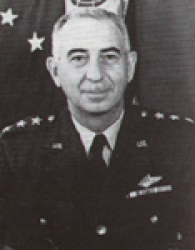
 |
|
|
||
|
Joseph Smith |
||||
|
Engagements: • World War II (1941 - 1945) |
||||
| Biography: | ||||
|
Joseph Smith Joseph Smith was born on 31 October 1901 in Scranton, PA. He graduated from the U.S. Military Academy on 12 June 1923. Smith was commissioned as a Second Lieutenant of Cavalry and assigned to the Eighth Cavalry at Fort Bliss, TX. In October 1924, he joined the Second Machine Gun Squadron at Fort Bliss, and later became Squadron Adjutant. The Russians cut off all road, rail and water links to West Berlin in June 1948. The task of supplying Berlin by air fell upon the U.S. Air Force in Europe, commanded by Major General Curtis E. LeMay. He had at his disposal 102 C-47s, each with a cargo capacity of 3 tons, and 2 of the larger C-54s that could each carry 10 tons. It was typical of LeMay to delegate tasks to the right person for the job, and he appointed Brigadier General Joseph Smith as Berlin Airlift Task Force Commander for an operation expected to last about two weeks. Smith called it 'Operation Vittles' because, "We're hauling grub" and immediately instituted procedures that were, in large part, used for the entire airlift that sustained two million West Berliners. The U.S. and British transports landed every 3 minutes at Tempelhof Field; on their return trip, the planes flew out products from Berlin's factories. Major General William H. Tunner replaced Smith as task force commander on 30 July 1948 and the Russians lifted the blockade in May 1949. In November 1948, he was assigned to the Office of the Deputy Chief of Staff for Operations at U.S. Air Force Headquarters in Washington and, in December, became Chief of the Plans Division in that office. The following September, he was appointed Deputy Director of Plans and Operations in the same office, with added duty as the Air Force member of the Joint Strategic Plans Committee of the Joint Chiefs of Staff. In July 1950, the director of plans and operations was split into two directorates, and Smith became Director of Plans in July 1951. Smith assumed command of the Military Air Transport Service (MATS) headquartered at Andrews AFB, MD, on 15 November 1951. MATS ferries troops, their families and cargo for the Armed Forces. MATS achieved several notable successes under his direction. His personal crusade involved efforts to increase the command's flight safety record and accidents declined by 75 percent during his tenure. He was also instrumental in preparing DoD Directive 5160.2, dated 7 December 1956, which designated MATS as the Single Manager Operating Agency for Airlift Services. Under Smith's leadership, MATS conducted several critical operational activities: The airlift to support the Korean War (1951-53); transportation of French Legionnaires from Saigon, South Vietnam, following French withdrawal (1954); airlift in response to the Suez Crisis (1956); and the movement of Hungarian refugees fleeing the country following a Soviet invasion (1956-57). He had the distinction of serving as Commander of MATS longer than any other individual, retiring from the position, and the USAF, on 29 June 1958. He was rated a Command Pilot, Combat Observer, Aircraft Observer, and Technical Observer. Medals and Awards Distinguished Service Medal Honors In 1995, Lieutenant General Smith was posthumously inducted into the Airlift/Tanker Association Hall of Fame. Death and Burial Lieutenant General Joseph Smith died on 19 May 1993 at Andrews AFB Hospital, MD, at the age of 91. The cause of death was heart failure due to respiratory distress. Prior to his death, he had been living in a military retirement home at Fort Belvoir, VA. He is buried at Arlington National Cemetery in Arlington, VA. http://www.findagrave.com/cgi-bin/fg.cgi?page=gr&GRid=59769204 |
||||
| Honoree ID: 3304 | Created by: MHOH | |||
Ribbons
Medals
Badges
Honoree Photos
 |  |  |
 |  |
 |


